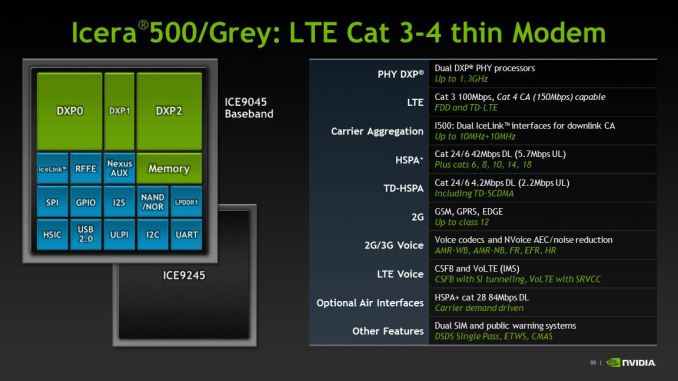NVIDIA Plans To Wind Down Icera Modem Operations In 2016
by Brandon Chester on May 5, 2015 6:25 PM EST
Today NVIDIA announced plans to wind down their Icera modem operations in the latter half of their fiscal 2016. Icera was originally an independent British semiconductor company before they were purchased by NVIDIA in 2011 for $367 million dollars. Their operations primarily focused on software and hardware design for wireless modems, with a strong focus on the software side. Their main product offering was their line of software modems (often shortened to softmodem) for use in cellular hotspots, computers, and mobile devices.
All modems function through a combination of hardware and software. However, at the time of NVIDIA's purchase, Icera's solution was significantly more software based than Qualcomm's. Since Qualcomm was really the only big name in modems at the time, NVIDIA's purchase of Icera made sense in order to ship future Tegra chips without having to rely on external basebands.
Unfortunately, NVIDIA's efforts to ship SoCs with integrated modems in the mobile space haven't worked out as well as planned. While there have been some past design wins for discrete Icera basebands such as in the ZTE Mimosa X, NVIDIA wasn't able to drive adoption of their Tegra 4i SoC with its integrated Icera i500 baseband. As a result, Tegra chips since that time have almost entirely relied on external modems from Qualcomm or other manufacturers, with the discrete i500 only being used a handful of times.
Since then NVIDIA has shifted their focus away from mainstream cell phones and tablets and towards more niche products – the company’s press release specifically calls out gaming, automotive and cloud computing – so the company has not needed an in-house baseband solution as urgently as they once did. Meanwhile for NVIDIA’s immediate future, they expect their existing Icera basebands to meet their needs for the next year (or more), and longer term NVIDIA expects to partner with 3rd party baseband suppliers in a fashion similar to what their customers are already doing today.
NVIDIA's press release states that Icera currently employs around 500 employees, which are mostly located in the United Kingdom and France. No longer having a need for Icera themselves, they are open to a sale of Icera's technology or the company itself. It's unlikely that they'll be able to sell the company for anything near the original $367 million dollars that they paid, as many different companies have begun to offer their own softmodem products in the years since then.
Source: NVIDIA (via SH SOTN)











25 Comments
View All Comments
Murloc - Wednesday, May 6, 2015 - link
in Europe you're usually insured against joblessness under various systems depending on the country, so the need for an emergency fund is quite more limited.psychobriggsy - Wednesday, May 6, 2015 - link
I'm sure these employees will not have much trouble finding new jobs if Icera doesn't get bought by another company. There's a good chance that the company will get bought, but as the article says, for a lot less that Nvidia paid - there are a lot of SoC designers out there. LG could be a candidate, they like buying cast off technology (WebOS, etc), and they are working on their own SoC designs.jjj - Wednesday, May 6, 2015 - link
So they are out of phones for real and that's no fun (for us).Long term this is tricky, as the form factor shifts to likely glasses,they would be out of that too and that's not ideal since computer vision is one of their things.
Ofc it's hard to say where connectivity wil be in 5-10 years and if not having a modem would block their access to the new form factors. Even if a complex integrated modem is still needed, ARM and the likes could license such IP by then.
More competition would have been nice in mobile and their future in consumer CE isn't too bright right now so makes you wonder about their trajectory in the next 10 years.
Do wonder if they'll cooperate with a major player on LTE or maybe invest in someone like Altair Semiconductor (like Sandisk did recently).
testbug00 - Wednesday, May 6, 2015 - link
How is it no fun? They never had a compelling phone product. The best they had was a small gap between the 40 --> 28nm transition when they had Tegra 3. Even that wasn't really compelling. Even in tablets their product isn't that compelling going by the numbers in general. Or they asked to much for it, I don't know if Nvidia was aiming for the same kind of premiums it generally has in the consumer GPU market.In the phone space, didn't even lose a competitor. In the tablet space, perhaps. However, Samsung's new efforts along with Mediatek, Huawei, Rockchip, and more, I don't think that losing NVidia's chips there is that bad.
Now, if this means they're pulling out of CPUs altogether, I would be sad. I want to see what they can do with their custom ISA core.
sonicmerlin - Monday, May 11, 2015 - link
I think their tablet GPUs are pretty awesome. The Denver CPU performed well on benchmarks even if performance was inconsistent in the Nexus 9. But that may be lollipop's fault